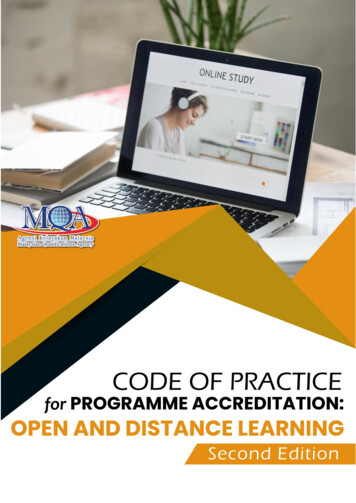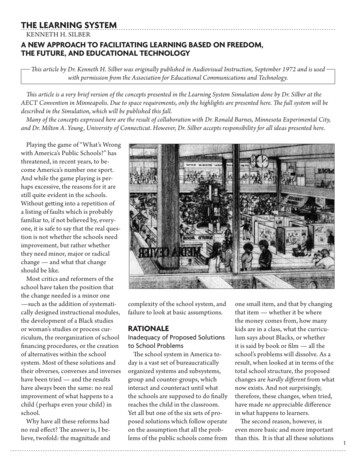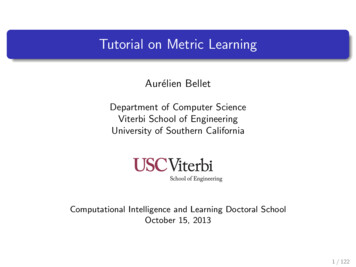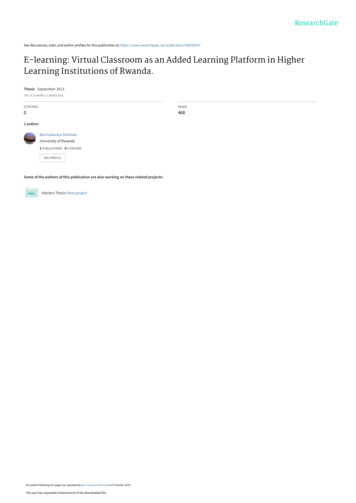
Transcription
THE LEARNING GUIDE: A HANDBOOK FOR ALLIED HEALTH PROFESSIONALS FACILITATING LEARNING IN THE WORKPLACEThe Learning Guidea handbook for allied health professionalsfacilitating learning in the workplaceThis is a user-friendly handbook designed tosupport teaching and learning of allied healthprofessionals locally within their workplaces.It provides information about: Practical strategies to facilitate adultlearning Optimising opportunities for learningand teaching within day-to-day workThis handbook is not a policy document.It gives tips and suggestions based onpublished evidence that supports effectivemethods of promoting education, learningneeds and professional development ofallied health professionals working in clinicalsettings, to contribute to the safety and qualitycare of patients/clients of NSW Health.HETIISBN 978- 0- 98719 36-7-4The Learning Guidea handbook for allied health professionalsfacilitating learning in the workplaceMay 2012FIRST EDITIONHETI RESOURCE
The Learning Guidea handbook for allied health professionalsfacilitating learning in the workplace HETI 2012F I R ST E D ITI O NLook for updates on the website:www.heti.nsw.gov.au
TH E LEAR N I NG G U I DENSW Health Education and Training Institute (HETI)Building 12Gladesville HospitalGLADESVILLE NSW 2111Tel. (02) 9844 6551Fax. (02) 9844 6544www.heti.nsw.gov.auinfo@heti.nsw.gov.auPost: Locked Bag 5022GLADESVILLE NSW 1675National Library of Australia Cataloguing-in-Publication entryTitle: The learning guide : a handbook for allied health professionals facilitatinglearning in the workplace/Health Education and Training Institute.SHPN: (HETI) 120230ISBN: 9780987193674 (pbk.)Notes: Includes bibliographical references.Subjects: Allied health personnel – In-service training – New South Wales.Medical personnel – In-service training – New South Wales.Other Authors/Contributors: Health Education and Training Institute.Dewey Number: 610.715Suggested citation:Health Education and Training Institute. The Learning Guide a handbook for alliedhealth professionals facilitating learning in the workplace. Sydney: HETI, 2012.This work is copyright. It may be reproduced in whole or in part for study or trainingpurposes subject to the inclusion of an acknowledgement of the source. It may not bereproduced for commercial usage or sale. Reproduction for purposes other than thoseindicated requires written permission from HETI. HETI May 2012.For further copies of this document, please contact HETI,or download a digital copy from the HETI website: www.heti.nsw.gov.au
ForewordThe Health Education and Training Institute (HETI) is delightedto present The Learning Guide: A handbook for allied healthprofessionals facilitating learning in the workplace. This documentis an exciting complement to The Superguide: A handbook forsupervising allied health professionals.Along with supervision, facilitating the learning of others is consideredan integral part of a health professional’s role. With some of the mostvaluable learning and teaching experiences occurring as part ofeveryday duties, there is an opportunity to advance the skills and knowledge of the alliedhealth workforce through workplace learning as the driver of education. This resourceprovides clinically relevant and practical information that focuses on the needs of cliniciansat the point of health care delivery who wish to further develop their skills as facilitators oflearning in the workplace.Allied health professionals are recognised as essential members of the multidisciplinaryteam playing a critical role in prevention, treatment and management of complex co morbidities across the continuum of care, reducing the impact of chronic disease andincreasing patients’ quality of life.It is hoped this document will be welcomed by the many dedicated allied healthprofessionals working in the NSW Health system as a user friendly guide to facilitatelearning through their everyday interactions with patients/clients, staff, colleagues andmanagers.HETI Chief ExecutiveHeather GrayF I R ST E D ITI O NHETITH E LEAR N I NG G U I DEiii
TH E LEAR N I NG G U I DEAcknowledgementsThis handbook was written by ‘The Learning Guide’ working group:ivDaniella PfeifferSenior Program OfficerAllied Health Education & TrainingHealth Education and Training InstituteJacqueline DominishSenior Program OfficerAllied Health Education & TrainingHealth Education and Training InstituteSue Steele SmithEducation Consultant and ManagerRoyal Rehabilitation CollegeRoyal Rehabilitation CentreNadine ThompsonDiagnostic RadiographerWestmead HospitalSydney Western Sydney LHDRuth VoSenior Gastro DietitianLiverpool HospitalSouth West Sydney LHDDavid RobertsPhysiotherapist & MusculoskeletalClinical EducatorConcord HospitalSydney LHDMelissa WelshOccupational Therapy ManagerBroken Hill Health ServiceFar West LHDJill HummellManager, Community Integration ProgramBrain Injury Rehabilitation ServiceWestern Sydney LHDThe project was overseen by the HETI Allied Health Advisory Committee.Design by Clik Creative.Contributions and reviews were provided by many people, in particular:Danielle CollinsProject Coordinator on SecondmentHETI Allied Health DirectorateOccupational TherapistPrince of Wales HospitalSouth East Sydney LHDRob WilkinsLearning and Teaching CoordinatorInterprofessional Practice/Team HealthCentre for Learning and TeachingHealth Education and Training InstituteStephanie O’ReganCurriculum Development SimulationCentre for Learning and TeachingHealth Education and Training InstituteContributions and reviews were provided by many people. A list of key contributorsis provided on page 93.
ContentsivPart 3: What skills are neededto facilitate learning?22About this guide3Introduction: Skills to facilitate learning23Allied health in NSW Health4Building relationships that support learning24Roles and Responsibilities5Communicating effectively25The Learning Journey6Facilitating discussion27Developing the professional along thecontinuum of learning28Promoting skill acquisition along thecontinuum of learning29What is workplace learning in a clinical setting? 10Facilitating a deep approach to learning30What does facilitating learning mean?11Setting learning objectives31Who is a facilitator of learning?12Advanced questioning techniques33Informal and formal learning13Facilitating reflective practice35Facilitating clinical reasoning36Facilitating an evidence-based practiceapproach37Part 2: Understanding the adult learner 16Giving effective feedback to learners39Introduction: Understanding the adult learner17Learning styles, preferences and strategies18Managing challenging behaviours inlearning activities41Considering individual differences whenfacilitating learning19Self-directed learning20Part 4: The where and how offacilitating learning in the workplace44Introduction: Where and how does learningoccur in the work place45Creating an optimal learning environment46Facilitating learning in one to one situations47Facilitating learning using case or clinicalscenarios48Facilitating learning in groups50Facilitating learning in a lecture or presentation52Facilitating learning in workshops54ForewordsiiiAcknowledgementsPart 1: What is workplace learning?8Introduction: Understanding workplace learning9Facilitating learning in regional, rural or remotelocationsTips to foster self-directed learningF I R ST E D ITI O N1421Facilitating learning in an in-service55Facilitating learning through a journal club56Facilitating learning using simulation58Facilitating learning through electronic media59Facilitating learning interprofessionally60Facilitating learning through communitiesof practice62HETITH E LEAR N I NG G U I DE1
TH E LEAR N I NG G U I DEContents continuedPart 5: Evaluation ofWorkplace Learning64Introduction: Why is evaluation oflearning important?65Purpose of evaluation66Evaluating informal learning66Evaluating workshops, seminars, in-services68Key points to remember when conductingan evaluation70Part 6: Appendices71Appendix A: Bloom’s Taxonomy73Appendix B: Useful web links75Appendix C: Tools to evaluate evidence78Appendix D: The giving and receivingfeedback quiz80Appendix E: Clinical scenario workedexample – Dietetics82Appendix F: Skills for effective facilitationof learning in large groups84Appendix G: Session/workshop/lectureplan – Template85Appendix H: Workshop plan – Workedexample86Appendix I: Optimising use of a learningresources in lectures or presentations87Appendix J: Strategies to delivering aneffective conference presentation88Appendix K: Small group activities90Appendix L: Critical appraisal journalreview – Template92Further Acknowledgements93Glossary of terms94References962
About this guideThe Health Education and Training Institute (HETI) provides state-wide leadership andcoordination in education and training of clinical and non-clinical health professionalsworking in NSW Health to ensure that the workforce has the necessary skills andknowledge to deliver high quality patient care to the people of NSW.HETI has produced this guide in response to requests from many allied healthprofessionals for practical guidelines to facilitate clinical education and learning in theworkplace. Along with their roles in supervision, operational management and leadership,many allied health professionals are involved in facilitating clinical education and learningon a day-to-day basis, particularly in skill development and practice.This guide is not a policy document. It provides information and guidelines based uponpublished evidence that supports effective methods of promoting education, learningneeds and professional development of allied health professionals working in clinicalsettings, to contribute to the safety and quality care of patients.It is acknowledged that education terminology and continuing professional development(CPD) requirements vary across the individual allied health professions. It is also importantto recognise that each discipline has different qualification and training requirements andapproaches to formally assessing competencies. However, common to all allied healthprofessional roles is the opportunity to facilitate learning within everyday clinical activity.To do this, allied health professionals need to have the confidence and skills to effectivelyfacilitate learning in others. This guide aims to provide user-friendly information to equipallied health professionals with practical strategies to become effective facilitators oflearning in the clinical setting. It is hoped that the principles of this guide can be appliedto all allied health professionals throughout their careers.This document should be used in conjunction with existingdiscipline-specific requirements and Local Health District* policies.It also complements The Superguide: A handbook for supervisingallied health professionals, and cross-references can be foundthroughout this guide. It will be reviewed regularly to ensure thatinformation is current and useful.Updates and other useful resources are available on the websiteof the Health Education and Training Institute: www.heti.nsw.gov.auThis guide has been written for allied health professionals of all levels ofexperience who could potentially facilitate learning within their workplaces.* The term Local Health District used in the context of this document refers inclusively to Speciality Health and HospitalNetworks such as St Vincent’s Health Network, Forensic Hospital Speciality Network and Sydney Children’s HospitalsSpeciality Network.F I R ST E D ITI O NHETITH E LEAR N I NG G U I DE3
TH E LEAR N I NG G U I DEAllied health in NSW HealthAllied health professionals:4 hold tertiary qualifications. hold relevant registration, license or accreditation to practise, eligibility formembership of professional associations. provide a range of therapeutic and diagnostic services in either the public, primaryhealth or private health care sector. apply their skills and knowledge to restore and maintain optimal physical, sensory,psychological, cognitive and social function in their clients/patients. use a range of complex skills including specific professional clinical skills in additionto communication, clinical reasoning, reflection and evidence-based practice skills. work as sole practitioners and/or in teams, including multidisciplinary, interdisciplinary,and transdisciplinary. are allied or align with each other and other members of the health professionalworkforce, their patient/clients, their families, carers and community working acrossthe health system.NSW Health categorises the following 23 professions as allied health professionals*:Art TherapyNutrition & DieteticsPodiatryAudiologyOccupational TherapyPsychologyCounsellingOrthopticsRadiation TherapyDiversional TherapyOrthotics & ProstheticsRadiographyExercise PhysiologyPharmacySexual Assault WorkersGenetic CounsellingPhysiotherapySocial WorkMusic TherapyPlay Therapy/Child LifeTherapySpeech PathologyNuclear Medicine TechnologyWelfare Officer* Information provided by Brenda McLeod, Chief Allied Health Officer, Workforce Development and Innovation Branch,NSW Ministry of Health as per NSW Treasury Codes Classification System.
Roles and responsibilitiesWithin NSW Health, depending on job roles and responsibilities, all staff cancontribute to facilitating their own and others’ learning in the workplace.Allied Health CliniciansAll health professionals have a responsibility to engage in lifelong learning, to keep up todate with the changing work environment and current evidence-based practice, and toensure they invest time in their own professional development (NSW Health, 2005). Clinicianscan facilitate not only their own learning, but the learning of others through the sharingof knowledge, resources and information, and harnessing opportunities to engage inprofessional networks and communities of practice.Student EducatorsStudent educators are responsible for discipline-specific clinical supervision, teachingand coordination of educational activities for students on clinical placements within oneor more health facilities (NSW Health, 2011).Allied Health Professional EducatorsSome NSW Health Local Health Districts and Speciality Networks may employ alliedhealth professionals who are responsible for the design, development, delivery andevaluation of education programs including continuing professional education, newgraduate orientation and general staff development courses (NSW Health, 2011).Managers/Team Leaders/Department and/or Unit HeadsAllied Health Managers, Team Leaders, Department or Unit Heads have a responsibilityto provide a supportive environment for professional development and to foster thedevelopment of learning organisations. Managers, Team Leaders, Department or UnitHeads are encouraged to promote an environment where the sharing of informationand resources between staff, across other discipline groups and Local Health Districtboundaries can occur.Allied Health DirectorsAllied Health Directors are responsible for the professional management of allied healthservices in Local Health Districts and Specialty Networks. Allied Health Directors have aresponsibility to engage, facilitate, support and provide strategic oversight of allied healtheducation and training and to provide advice to improve overall systems of governancefor allied health.NSW HealthNSW Health has a responsibility to set policy direction and provide physical and humanresources to ensure that the organisation is responsive to the education needs of staffand that all employees receive appropriate learning and development opportunities tofacilitate the delivery of safe, high quality health care.Health Education and Training Institute (HETI)HETI has leadership responsibility for the education and training of clinical and nonclinical health professionals working in NSW Health. HETI works closely with LocalHealth Districts, Learning and Development Units and other public health organisationsand clinical training providers to develop and support the delivery of education andtraining across the NSW public health system.F I R ST E D ITI O NHETITH E LEAR N I NG G U I DE5
TH E LEAR N I NG G U I DEHow do adults learn?What is workplace learning?Part 1: What is workplacelearning? (page 8)‘Within allied health manyopportunities exist forlearning with, from andabout each other’6The Learning JourneyWhere can I use these skills?How do I evaluatewhat I have done?Part 5: Evaluation of workplacelearning (page 64)‘Evaluation is an essentialpart of any workplacelearning activity and shouldbe seen as a continuous cycleof reflection and improvement’(Morrison, 2003)
?How do adults learn?What skills do I need?Part 2: Understandingthe adult learner (page 16)‘Facilitating learning amongcolleagues can be doneformally or informally’7arning?How do adults learn?What skills do I need?Part 3: What skills areneeded to facilitatelearning? (page 22)‘Facilitating learningrequires a range of skillsand approaches that buildon learners’ experiencesand expertise’How do I evaluatewhat I have done?Where can I use these skills?Part 4: The where andhow of facilitating learningin the workplace (page 44)‘Facilitating learning is asmuch about setting up thelearning environment as it isabout extending knowledgeor sharing expertise’(Hutchinson, 2003, p. 810)F I R ST E D ITI O NHETITH E LEAR N I NG G U I DE
TH E LEAR N I N G G U I D EPart 1What is workplace learning?88What is workplace learning?
Introduction: Understanding workplace learningThe workplace is one of the richest environments to facilitate the development of skills andknowledge required to deliver high quality patient care. While access to formally arrangedand organised education is highly valued by allied health professionals, there is also alarge range of enriching experiences and learning opportunities which form part of ourday-to-day work. By seizing opportunities to learn within our workplaces we can maximiseopportunities to learn from, with and about each other as we engage in workplace activity.Before we can start to engage in facilitating learning within the workplace, it is importantto understand the concept and benefits of workplace learning (often referred to as workbased learning within the literature) as a model for professional development of alliedhealth professionals.Work based learning is defined as an approach that can “enable workplacetransformation to be achieved and sustained by ensuring that workplaceactivity is the driver of learning and development” (Manley, et al., 2009, p. 88)Work-based learning in a clinical setting has a number of benefits including: Being driven by the needs of patients/clients and health services to directly improvequality of care Supporting the implementation of evidence at the local level Using the potential to improve productivity Being cost-effective Increasing work satisfaction(Manley, et al., 2009)Some key concepts explored in this section are: What is workplace learning in a clinical setting? What does facilitating learning mean? Who is a facilitator of learning? What are the attributes of an effective facilitator of learning? Informal and formal learning Facilitating learning in a regional, rural and remote locationsBy seizing opportunities to learn within our workplaces we can learnfrom, with and about each other as we engage in workplace activity.F I R ST E D ITI O NHETITH E LEAR N I NG G U I DE9
TH E LEAR N I N G G U I D EWhat is workplace learning in a clinical setting?Effective workplace learning relies on allied health professionals who are able to recogniselearning opportunities, and who are willing and able to communicate and share theirprofessional knowledge (Spouse, 2001). This can occur as part of everyday duties, such aswhen talking to a colleague about a clinical dilemma (facilitating your own learning)or helping a recent graduate gain confidence with a procedure or task (facilitatinglearning in others).10Terms such as continuing professional development (CPD) and lifelong learning (LLL)are closely associated with workplace learning: they rely on the allied health professionaland organisation to create an environment where expertise is shared, learning needs areidentified and plans are made to meet these needs (Spouse 2001).There are many opportunities available to facilitate learning within the workplace.Some examples include: Journal club Tea room conversations Supervision On the ward Case conferences On home visits In-service presentations In the clinic Joint consultations Peer learning Interprofessional learning Journal clubsSome of these opportunities are explored further in Part 4 – The Where and How ofFacilitating Learning in the Workplace.So there are opportunities in virtually any clinical activity that I can useto facilitate learning.
What does facilitating learning mean?When thinking about facilitating learning, it is helpful to distinguish among the terms‘education’, ‘training’ and ‘facilitation’, although they are often used interchangeably(McKimm & Jollie, 2007).‘Education’ is a ‘process by which one develops abilities, attitudes and other forms ofbehaviour considered to have value in the society in which one lives’ (UNESCO, 2011).‘Training’ has traditionally been viewed as discrete planned events used to instruct peoplehow to perform specific defined skills or procedures (Marsick & Volpe, 1999). In many aspectsof our work as allied health professionals, training is commonplace, such as ‘on the job’skills training or formalised training which is generally recognised with a qualification orcertificate (Halliday-Wynes & Beddie, 2009).‘Facilitation’ can be described as ‘a process of teaching in which the teacher endeavoursto create a learning environment which is conducive to learning and aims to enable orempower the learner’ (McAllister, 2004, p.219).Facilitation places emphasis on the learning process and outcome,to achieve purposeful, self-directed learning that is meaningful tothe clinical setting and the delivery of quality patient/client care.Who is the learner?Professionals should be continually engaged in learning. LLL enables us to keep up-to date with the latest evidence-based practice, adapt practice to meet patient needs, andultimately provide the best possible care to our patients and clients. CPD and LLL arepromoted by professional associations as best practice and CPD is now a mandatoryrequirement in an increasing number of allied health professions to maintain registrationto practise or eligibility for professional association membership/professional certification.We are all learners. Regardless of age, expertise and years of experience,all allied health professionals should be continually engaged in learning.F I R ST E D I T I O NHETITH E LEAR N I N G G U I D E11
TH E LEAR N I N G G U I D EWho is a facilitator of learning?Everyone is considered to be a learner and everyone has the potential to be a facilitatorof learning. This guide considers a facilitator to be an allied health professional workingalongside others to help transform themselves as individuals, team members andorganisational employees. A facilitator of learning can be a peer, supervisor, mentor ormanager. Learning facilitation can develop through a pre-established arrangement, suchas via a line management or supervisor, or sourced through other relationships such as ateam member, peers, social networking or communities of practice.12Everyone can be a facilitator of learning.What are the attributes of an effective facilitator of learning? Encourages ‘hands on’ and interactive approaches to learning activities. Adapts the education and facilitation to the context in which the leaning occurs. Establishes learning goals and objectives that are clear, achievable and relevant. Seeks out opportunities to collaborate and negotiate learning processes with others. Acknowledges learners as ‘co-producers’ of new knowledge and skills. Recognises prior knowledge and life experience as valuable foundations for learning. Uses flexible teaching approaches that address’ different learning orientations. Values the social interactions involved with learning in groups. Directs the learner towards resources required to learn.(Adapted from Smith & Dalton, 2005)Which of these attributes have I seen in my workplace or foundbeneficial in my own learning experience?
Informal and formal learningInformal learningContemporary understanding of informal learning is that individuals acquire attitudes,values, skills and knowledge from daily experience which happens outside of formaltraining situations (Halliday-Wynes & Beddie, 2009).Informal learning ‘accounts for as much as 80-90% of all of our learning,in particular through the exposure to the opinions and practices ofothers also working in the same context’ (Matthews & Candy, 1999, p. 49).13There are a variety of ways in which informal learning can occur in a clinical setting: Work/practice experienceQuality improvement activitiesReflective practiceParticipating in meetingsPilot programsReadingSurfing the net Professional groupsSupervisionMentoringEveryday communicationNetworkingCritical incidentsRoot cause analysisFormal learningFormal learning refers to learning that occurs in structured programs. This may includeanything from running an in-service in your workplace to doing postgraduate study.Combining different forms of learning, and choosing an approach that ‘best fits’ aparticular context or skill, it provides a coherent approach to workforce skill developmentas learners can be integrally involved with determining what is needed to achieve theirlearning goals (Misko, 2008).So informal learning would include discussions with other allied healthcolleagues about how they managed a challenging situation or listeningto a colleague explaining something to another colleague/student.F I R ST E D I T I O NHETITH E LEAR N I N G G U I D E
TH E LEAR N I N G G U I D EFacilitating learning in regional, rural or remotelocationsWorking in a regional, rural or remote context requires a unique skill set. The professionalknowledge required by remotely located health professionals is similar to that required formetropolitan practice, but the challenge is the divide between specialist and generalistknowledge (Stagnitti, 2008).14An allied health professional working in a regional, rural or remote setting needs to beable to: work in geographically dispersed interprofessional teams take on greater responsibility, often with access to fewer formal co-locatedprofessional support structures provide services within broad clinical practice areas work with culturally diverse populations(Lin, et al., 2009)The rural and remote allied health professional also faces challenges associated withhigh client–therapist caseloads and covering large geographical regions (Stagnitti, 2008).But these challenges can also be turned into opportunities for learning. Of course, itis acknowledged that these challenges are not necessarily unique to rural and remotesettings. Tips have been inserted throughout this guide to highlight useful informationfor allied health professionals to consider when working in a regional, rural or remotecontext.Look out for this tip box which appears throughout the guide.RURALTIPRural practitioners may not have the opportunity to participate in things likein-service programmes or journal clubs, especially if they are working ontheir own in a geographically isolated region. The rural tips are present inthis guide to draw attention to ways of learning that can be applied in moreremote workplaces, whether or not there are other allied health professionalsin the vicinity to learn from. Geographical isolation should not preventfacilitated learning at work.For example: The relatively high turnover of the workforce in regional areasis a challenge for managers and health services to manage. It is also achallenge for the allied health professionals who continue to work in theregion. But it can also be an opportunity to access a wider variety of healthprofessionals with a wide range of skills and experiences as replacementstaff join the team. Learning from peers is achievable when existing staff takean interest in facilitating the sharing of knowledge with newer staff in theworkplace and when management supports such initiatives.
Reflective questionsHere are some reflective questions to get you thinkingabout how you might apply some of this information in yourworkplace.15 What opportunities are there in your workplace to facilitatelearning? What interests you in becoming a facilitator of learning? What are some steps you can take to become a facilitatorof learning? List some attributes you have that will make you aneffective facilitator of learning.F I R ST E D I T I O NHETITH E LEAR N I N G G U I D E
TH E LEAR N I N G G U I D EPart 2Understanding the adult learner16How do adults learn?
Introduction: Understanding the adult learnerTo facilitate learning within a health care setting, it is important to understand thespecific needs and attributes of adult learners. Adult learning principles stress the valueof experience in the learning process, the adult learner’s self-concept and motivation tolearn and the importance of self-directed learning (Boud, 1987).Adult learners: Need to be respected, valued and acknowledge for their past experience and tohave the opportunity to apply this experience to their current learning Learn best in environments that reduce possible threats to self-concept andself-esteem and provide support for change and development Are highly motivated to learn in areas relevant to their current needs, often generatedby real life tasks and problems Need feedback to develop Value self-directed learning and learn best when they can set their own pace Learn more effectively through experiential techniques (e.g
The Health Education and Training Institute (HETI) is delighted to present The Learning Guide: A handbook for allied health professionals facilitating learning in the workplace. This document is an exciting complement to The Superguide: A handbook for supervising allied health professionals.










